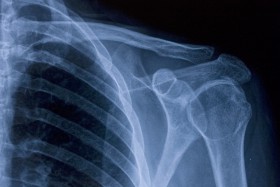The Facts About Clavicle Fractures in Newborns

Even though great progress has been made in making childbirth a safer process for both the mother and child, birth injuries do still occur. Birth injuries take many different forms, but broken bones are one of the most common kinds. According to Nationwide Children’s Hospital, clavicle fractures in particular are the most common kind of birth injury newborns sustain during birth.
What Causes Newborn Clavicle Fractures?
A baby’s body is very delicate and during the delivery process, a lot of strain can be put on the child’s shoulder and collarbone area. In many cases, clavicle fractures occur in larger-than-average infants and/or during difficult deliveries. Sometimes, a child’s arm will be in a less-than-ideal position as it moves through the birth canal. If the child’s shoulder becomes stuck behind the mother’s pelvic bone, known as shoulder dystocia, this can increase the risk that the baby will be born with a broken collarbone. Birth-assisting tools can also result in clavicle fractures if they aren’t used correctly.
Symptoms of Clavicle Fractures in Newborns
One of the hardest things about having an injured newborn is that they aren’t able to tell you there’s a problem. An older child or adult will be able to say that they’re experiencing pain or tell you about other symptoms they might have. But with babies, you have to know the symptoms to watch for. An infant born with a broken clavicle might keep one arm close to their body and refuse to move it. If you try to move the impacted arm for the child, they might begin to cry. As weeks pass, you may begin to notice a hard lump in the impacted area, which naturally occurs as the injury heals.
In some cases, a broken clavicle can be more than just a bone injury. About 1 in 11 newborns born with a fractured clavicle also have a brachial plexus injury, which is an injury to a group of nerves that extends from the spine and through the neck and arms. If this is the case, the child might be unable to move the impacted arm.
Newborn Clavicle Fracture Diagnosis & Long-Term Effects
If you suspect your child has a fractured clavicle, an X-ray will be able to make the diagnosis. The sooner a fracture is diagnosed, the more likely it is the child will fully recover without long-term complications. But if the fracture doesn’t heal properly and the injury is severe enough, it can cause problems like a limited range of motion, delays in developing motor skills, and numbness in the impacted arm.
Contact a Birth Trauma Lawyer
Although clavicle fractures in newborns are common, that doesn’t necessarily mean they’re unavoidable. If your child experienced a broken collarbone at birth and you feel like it could have been prevented, contact a birth trauma lawyer. The tragic reality about birth injuries is that they so often occur because of negligence. It’s always upsetting to have an injured child, but a lawyer will be able to help answer your questions and figure out what to do next. At Goodwin & Scieszka, you’ll be able to speak to a lawyer with experience helping birth trauma victims in the state of Michigan. Contact us today for help with your case.






